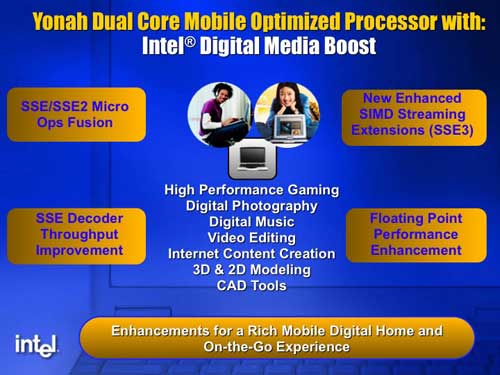Intel Yonah Performance Preview - Part I: The Exclusive First Look at Yonah
by Anand Lal Shimpi on November 30, 2005 2:50 AM EST- Posted in
- CPUs
Same Size, but Twice the Cores
Obviously the biggest improvement Yonah offers over Dothan is the fact that it’s dual core. But where things get interesting is that thanks to Yonah’s 65nm process, a dual core Yonah die is about the same size as a single core Dothan die - in other words, it costs Intel just as much to make a dual core Yonah, as it did for them to make a single core Dothan.
A major reason the die size didn’t really go up much is because although Yonah has two cores, its L2 cache size remains unchanged at 2MB. Unlike the Pentium D, Yonah’s 2MB L2 cache is not split into two discrete 1MB caches, it is actually one whole 2MB cache that is shared by both cores. This is a very important distinction, as it means that Yonah is far from just two Dothans stuck together.
There are other architectural enhancements to Yonah that will give it a performance advantage over Dothan. Below is an excerpt from our IDF coverage of Yonah, detailing what we know about the new CPU:
Making Pentium M more "Media Friendly"
All of the major performance improvements to each of Yonah's cores seem to revolve around SIMD FP and FP performance, two of the Pentium M's present day weaknesses in comparison to the Pentium 4.
The first improvement is that now all three of Yonah's decoders can decode SSE instructions, regardless of the type of instruction. Improving the decode width of the processor is a quick way to improve performance.
Next, SSE/SSE2 operations (not sure if all can be, but at least some) can now be fused using the Micro Ops Fusion engine of Yonah. At a high level, the benefit here is increased performance and lower power consumption, we'll get into architectural details of why that is when we eventually sink our teeth into Yonah next year.
Each of the two cores in Yonah have also received support for SSE3 instructions much like the Pentium 4 E [Prescott].
And finally there have been some improvements to Yonah's floating point performance, although Mooly would not say exactly what's been done. Curiously, Mooly referred to the floating point performance improvements as specifically made to improve gaming performance. Intel may have grander plans for Yonah than once thought...
The SSE/FP optimizations are all being grouped into what Intel is calling their Digital Media Boost technology, yes the names seem to get worse and worse as time goes on - but at least the functionality should be good.
We started out this article talking about the Pentium M’s shortcomings in digital media applications, and Intel has begun to address them with the architecture of Yonah, but the real question is - how effective have their efforts been?











135 Comments
View All Comments
nserra - Wednesday, November 30, 2005 - link
Well he is assuming it will, if not.... another Intel fiasco. But then, I’m still impressed with the power consuming numbers.But how will it scale performance/power consuming? At 2.6Ghz 20%?
xsilver - Wednesday, November 30, 2005 - link
my guess is that its an asus and it will be ridiculously priced.it will also be funny how intel will sell this as the "fastest" processor in the world . blah blah blah.. even though it still cant beat the p4 in video encoding
has it been reported that there will be wide desktop mobo support, unlike the pentium M series so far? more manufacturers need to get in on the action b4 even the possibility of it becoming cheap.
VooDooAddict - Thursday, December 1, 2005 - link
First version of a next generation Intel CPU... Slower then the previous generation? NEVER!nserra - Wednesday, November 30, 2005 - link
"Intel still needs to improve their video encoding and gaming performance, but it looks like we may have to wait for Conroe and Merom for that."Yes i will wait, the wait, wait. Wait for wait. You must wait for wait. Then wait will wait for wait. Then i will wait for wait.
Marlin1975 - Wednesday, November 30, 2005 - link
wow intel chaning the pin/board layout to force others to buy all new gear, who would have thought.
shabby - Wednesday, November 30, 2005 - link
Geez they moved one little pin just to spite us, friggin sad.Shintai - Wednesday, November 30, 2005 - link
Yonah and Dothan is electrical incompatible.You only end up with either a fried chip or simply no ability to even run it.
The new socket is however future proff. It will work with the Merom mobile chip aswell.
Nyati13 - Wednesday, November 30, 2005 - link
It's "rumoured" to be future proof, but Intel will probably change sockets between Yonah and Merom, like they always do.nullpointerus - Wednesday, November 30, 2005 - link
Um...how do you know they didn't just move the pin to prevent people from frying the chip in older boards? In other words, does Yonah have a completely different use for the pins, or is it just a marketing scam?Deathcharge - Wednesday, November 30, 2005 - link
I think Intel has a lot of potential, this is a great mobile cpu and we've come a long way from the original P4 (which is what I am using to type this comment). I think this is really just a taste of things to come and if I was AMD I would be looking at what else I have to remain competitive. Sure what they have is far better than anything Intel TODAY but this time next year might be a completely different story.